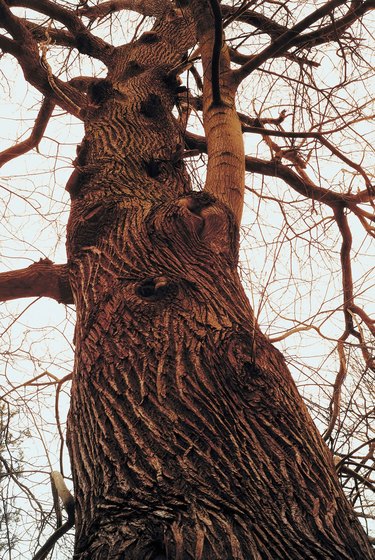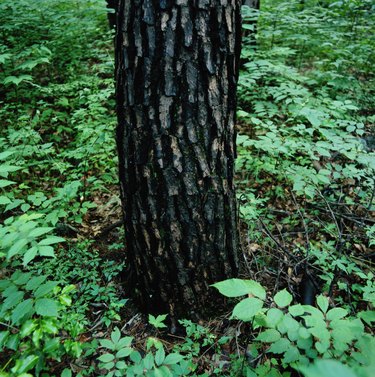
At first glance, the bark of ash trees and oak trees may seem similar. When the different varieties are looked at more closely and compared, however, there are some definite differences. Many ash trees develop raised ridges with a diamond-shaped pattern, but this is not true of all ash trees. Some oak trees and ash trees have scaly bark with subtle differences in color.
White Ash and Oak Trees
Video of the Day
White ash bark is gray. Its pronounced ridges are pale gray and range from quite narrow to medium width. The deep fissures between the ridges are dark gray to dark brownish-gray. Biltmore ash trees look like smaller white ash trees with deeper furrows and wider ridges in the bark. The ridges commonly form a diamond pattern on these ash trees.
Video of the Day
White oak bark is also gray with ridges and narrow furrows. As the tree matures, the ridges widen and develop a plated or scaly texture with narrow furrows in between the plates as opposed to the pronounced ridges and furrows on white ash bark. Post oak bark is similar to that of white oaks, but is darker and more rough, with smaller raised scales. Swamp white oak bark is a darker grayish-brown with deep irregular fissures and wide, rough, pronounced ridges. The ridges on white oak, post oak and swamp white oak bark do not form a diamond pattern.
Red Ash and Oak Trees
Red or green ash tree bark is thick and gray-brown with a red tint. The furrows in the bark are shallow. The pronounced ridges are rough and form a diamond pattern.
Red oak trees have gray-brown or gray bark with shallow furrows but the raised ridges are smooth and plated. Old red oaks often have sections of bark with no furrows. Young southern red oak bark is smooth but develops shallow furrows and more pronounced ridges as the tree ages. The color also darkens as the tree matures, eventually changing from pale gray to dark gray or black on older trees. The ridges on red and southern red oak tree bark do not form a diamond pattern.
Black Ash and Oak Trees

Black and European ash trees both have gray to brown-gray, fissured, scaly bark. The bark on these ash trees does not develop a diamond pattern. The scaly ridges on black ash tree bark crumble when they are rubbed or scraped.
Black oak trees have thick dark brown to black bark with rough raised ridges and deep wide fissures. Blackjack oak trees have scaly, fissured bark, somewhat similar to black and European ash, but it has a rougher texture. It is dark gray to almost black in color. Scarlet oaks have gray-brown to gray-black bark that is similar to blackjack oak bark but commonly has spots or marbling.
Blue Ash and Yellow Oak Trees
Blue ash tree bark is pale gray-brown or pale gray with a slight red tint. It is thick with coarse raised scales and narrow fissures. As the tree gets older, the scales widen, developing into course plates. The inner bark changes to blue when stripped from the tree, and when soaked in water will turn the water blue.
Chinquapin or yellow oak has pale gray to pale gray-brown scaly bark, similar to blue ash, but the scales are small. As the yellow oak ages, the scaly ridges develop horizontal breaks or small fissures. Older pin oaks have pale gray-brown bark with narrow fissures and raised scales similar to blue ash bark but the scales are small. Young pin oak trees have smooth, pale brown bark. The bark on these oak trees will not turn blue or turn water blue.
- University of Connecticut: Plant Database: Fraxinus Americana: White Ash
- University of Connecticut: Plant Database: Quercus alba: White Oak
- University of Connecticut: Plant Database: Quercus bicolor: Swamp White Oak
- University of Connecticut: Plant Database: Quercus rubra: Red Oak
- University of Connecticut: Plant Database: Fraxinus excelsior: Common Ash, European Ash
- University of Connecticut: Plant Database: Quercus velutina: Black Oak
- Missouri Botanical Garden: Kemper Center for Home Gardening: Quercus falcata
- Missouri Botanical Garden: Kemper Center for Home Gardening: Quercus prinus
- University of Connecticut: Plant Database: Quercus palustris: Pin Oak, Swamp Oak
- Ohio State University Extension: Ohio Trees: Fraxinus -- Ash
- Ohio State University Extension: Ohio Trees: Quercus -- Oaks